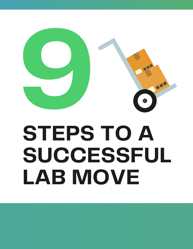You’ve seen the signs. You’ve heard the whispers. Just like winter, a lab move is coming. Lab relocations are complex, but can be mastered with careful planning. By following nine main steps, it’s possible to ensure a successful lab move.
- Requirements and space planning. Map out your requirements and plan the ideal space to accommodate your needs by creating two cornerstone documents: an equipment inventory and a space program.
- What’s an equipment inventory? A comprehensive list detailing the equipment your lab already has, as well as a wish list of all the new items needed for the new space.
- What’s a space program? A detailed plan outlining how the new lab space will be organized, configured, and utilized. Typically developed with an architect.
- New site search and selection. Engage a real estate broker to identify candidate properties, as well as work with architects to create test fits. Once a potential building is identified, engage general contractors to conduct a feasibility study.
- What’s a test fit? Basic planning drawings based on your space program and the new facility footprint, to ensure that everything planned will fit within the potential space.
- What’s a feasibility study? Assessment evaluating the practicality, viability, and potential success of relocating to said new location. Analyzes various factors to determine whether the move is economically, technically, and operationally feasible.
- Build design and budgeting. Design and budget for the build-out of your selected location, starting with MEP engineering and considering value engineering opportunities. Have all stakeholders sign off on blueprints to confirm design expectations and keep future change orders to a minimum.
- What’s MEP engineering? Specialized field that focuses on the design, installation, and maintenance of the mechanical, electrical, and plumbing systems.
- What is value engineering? Identification of cost-effective alternatives that meet project requirements while reducing overall expenses.
- What’s a change order? Request to modify, adjust, or add to the original scope of work, plans, or specs. Typically occurs when there is a need to alter aspects of the project that were not initially anticipated or included in the original contract or agreement.
- Lease negotiations and agreement execution. Negotiating leases and executing agreements can take time, so this step should begin once a site is selected. Before lease execution, conduct thorough building inspections to ensure suitability.
- Contract finalization and procurement. Finalize construction budgets and contractor agreements, as well as procure materials and equipment. A robust procurement process is crucial, particularly for long-lead items like ventilation systems and lab equipment.
- What is a lab supply marketplace? A scalable procurement solution, such as ZAGENO, that ensures continuous lab supply ordering, tracking, and delivery throughout a lab relocation and beyond. ZAGENO offers 5,300+ brands and 40 million+ different product SKUs, all in one place.
Go deeper: From Incubator to Independence: 5 Considerations for Biotechs Transitioning to Labs of their Own
- What is a lab supply marketplace? A scalable procurement solution, such as ZAGENO, that ensures continuous lab supply ordering, tracking, and delivery throughout a lab relocation and beyond. ZAGENO offers 5,300+ brands and 40 million+ different product SKUs, all in one place.
- Build-out permitting and construction. Secure landlord and city approval on plans before proceeding with construction. Once construction commences, stay actively involved and foster clear communication among trades and subcontractors to ensure defined responsibilities.
- Physical move planning and execution. Engage experienced, specialized, well-reputed movers. Identify critical equipment early and coordinate with manufacturers for handling and warranty concerns. Consider temporary storage needs due to lease expiration or construction delays. Invest in comprehensive coverage to help avoid costly damages and disputes resulting from accidents during the move.
- New site start-up. Leaving a university or incubator may mean increased staffing needs, in areas like facilities operations and environment, health and safety (EH&S). Don’t leave this step to the last minute. Also ensure supply inventories will be replenished in the new space, set up new vendors as needed, and communicate address changes to existing vendors.
- Legacy site decommissioning. Engage with regulators to ensure safe closure of your current site, including decontamination and inspections, well before deadlines. Review lease terms with the landlord to understand move-out requirements that might involve extensive deconstruction, to avoid unexpected tasks and delays.
- What is legacy site decommissioning? The process of safely and responsibly closing down and vacating the old site once relocation is complete, ensuring proper decontamination, cleaning, and preparation of the old site for handover to the landlord or new occupants.

Get your free, convenient one-page list of the 9 steps to a successful lab move
More tips for a successful lab relocation
Lindsey Fitzgerald, ZAGENO Senior Account Executive, and Nathan Foorman, Foorman Facilities Advising Founder & Principal Consultant, recently hosted biotech and pharmaceutical lab managers and procurement for a deep dive into lab relocation best practices in the webinar, “10 Pitfalls to Avoid When Moving Labs.” Using insights gained from numerous moves, the webinar explored key steps for a successful, seamless move to a new lab space and how to avoid common budget-draining mistakes.
Watch the webinar: 10 Pitfalls to Avoid When Moving Labs Webinar
Read the free ebook: 10 Pitfalls to Avoid When Moving Labs ebook




